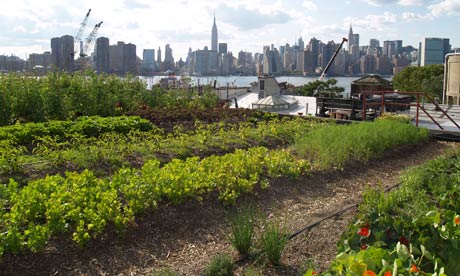 With the advent of increasingly innovative green technologies, architects are now more than ever able to fully maximize their sophisticated artistic visions, while simultaneously minimizing the negative environmental effects of their structures. As climates and resources shift, environmentally-conscious architecture is beginning to produce more and more complex, sustainable, and awe-inspiring buildings, signifying that green architecture is the wave of the future from both a creativity standpoint, as well as out of ecological necessity. In fact, in the most extreme and inventive cases, architects are now not only working to preserve the natural environment, but actually to positively affect, alter and improve it.
With the advent of increasingly innovative green technologies, architects are now more than ever able to fully maximize their sophisticated artistic visions, while simultaneously minimizing the negative environmental effects of their structures. As climates and resources shift, environmentally-conscious architecture is beginning to produce more and more complex, sustainable, and awe-inspiring buildings, signifying that green architecture is the wave of the future from both a creativity standpoint, as well as out of ecological necessity. In fact, in the most extreme and inventive cases, architects are now not only working to preserve the natural environment, but actually to positively affect, alter and improve it.
In its most basic form, green architecture signifies building designs and practices which predominantly utilize recyclable and renewable materials to create structures that operate on a minimal amount of energy. Efficient building models are able to run off of solar, wind, and sometimes water-powered energy generation and take up as little land as possible in order to preserve or encourage green space.
If you’re interested in more architecture inspiration, these posts will amaze you:
30 Incredibly Realistic Interior and Exterior CG Environments
50 Conceptual CG Buildings and Environments
30 Striking Architectural Photographs
A massive and trendsetting example of green architecture is the Hearst Tower in New York City, which in 2006 was the first building to become certified with an LEED Gold rating.

The towering skyscraper, which is built on top of the 1928 Hearst International Magazine Building, can boast that it was constructed out of 90% recycled materials and currently uses 26% less energy than is required by today’s standard building codes.
An even more space-age like recent example – one which dominates another skyline – is the Bahrain World Trade Center.

The complex’s two towers are connected by giant wind turbines, which are capable of providing up to 15% of the buildings’ total energy consumption.
And it’s not just about the skyscrapers. While plenty of private clients now choose to construct homes, offices, and schools out of recyclable materials, outfitting them with solar panels and energy-saving appliances, some properties go one step further, opting to adopt “green roofs.” This design choice is exactly what it sounds like: soil and grass-covered roofs that provide insulation for the home, give back the green space claimed by the building itself and, in the most sophisticated of cases, help to maintain the ecology for surrounding wildlife.

A stunningly simple residential example of this can be seen in the OS house built in Spain by NOLASTER Architects.
The art department at Nanyang Technological University offers an even more whimsical model.

This, however, is only the beginning. As green technology advances, so too do architects’ visions for its usage. Some, like Vincent Callebaut Architects’ “Lilypad Project”, which proposes ocean-based eco-city islands that run on collected rainwater, will most likely remain pure fantasy.

Others, like Sheila Kennedy’s “Soft House”, that makes use of solar-harvesting textiles, may simply be too costly to ever be put into mass production.

The ideas come in all shapes and sizes, from skyscrapers filled with agricultural farmland to single-family homes that run off of energy produced by the household’s own inhabitants and objects.

CK Designworks in Nanjing, China, has recently unveiled their design plans for a remarkably large eco-city development slated to begin construction shortly. And while some projects are focused on preserving natural resources and finding alternative energy sources, others like the Living Mountain, dream up the creation of entirely new micro-environments.

In this particular proposal, inhabitants will survive the growing desert landscape by building cities inside of massive, mountainous skyscrapers. While creating protection from the uninhabitable outside, the structure will also work to pull water from the region, cycling it inside to produce an entirely new climate and ecology.
One thing clear in all these plans, visions, proposals and dreams is that green architecture provides not only new challenges, but new opportunities for designers. It is an inspiring and growing field full of imagination and innovation, one which puts firmly in the architect’s hands the exciting responsibility of envisioning and constructing a new look for the future.
Source: Creativefan.com by Maria Nemenman










 With the advent of increasingly innovative green technologies, architects are now more than ever able to fully maximize their sophisticated artistic visions, while simultaneously minimizing the negative environmental effects of their structures. As climates and resources shift, environmentally-conscious architecture is beginning to produce more and more complex, sustainable, and awe-inspiring buildings, signifying that green architecture is the wave of the future from both a creativity standpoint, as well as out of ecological necessity. In fact, in the most extreme and inventive cases, architects are now not only working to preserve the natural environment, but actually to positively affect, alter and improve it.
With the advent of increasingly innovative green technologies, architects are now more than ever able to fully maximize their sophisticated artistic visions, while simultaneously minimizing the negative environmental effects of their structures. As climates and resources shift, environmentally-conscious architecture is beginning to produce more and more complex, sustainable, and awe-inspiring buildings, signifying that green architecture is the wave of the future from both a creativity standpoint, as well as out of ecological necessity. In fact, in the most extreme and inventive cases, architects are now not only working to preserve the natural environment, but actually to positively affect, alter and improve it.







